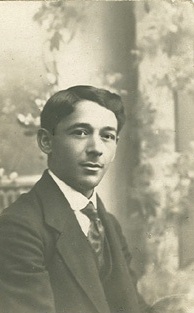Ahmed Agdamski
Ahmed Agdamski Аымед Агдамски | |
|---|---|
 | |
| Born | Əhməd Bəşir oğlu Bədəlbəyli January 5, 1884 |
| Died | April 1, 1954 (aged 70) |
Ahmed Agdamski (Azerbaijani: Əhməd Ağdamski) also known by the stage name of Ahmed Bashir oglu Badalbeyli (Azerbaijani: Əhməd Bəşir oğlu Bədəlbəyli) (January 5, 1884, Shusha, Elisabethpol Governorate (Russian Empire) – April 1, 1954, Agdash, Azerbaijan SSR) who was an Azerbaijani opera singer, mugam singer and actor.
Biography

Ahmadbey Badalbeyli was born on January 5, 1884, in Shusha, Azerbaijan. He attended circles of theater-lovers and participated in national spectacles from his childhood.[1]
Scenic activity of the actor began in 1910, with attendance of a theatrical troupe of “Nijat” charity union. He was famous for his performance of women roles in various operas in the early history of Azeri Opera, when women's appearance on stage was strictly forbidden by religion and tradition. But later he began to play male parts, too. Besides all these he also was engaged in pedagogic activity. He was always persecuted because of playing women’s parts. Ahmedbey changed his surname and address. For several years he was known as Miri. At the beginning of 1920’s he returned to Karabakh, where he established a theatrical troupe in Agdam city, in 1923. In 1934, he moved to Agdash.[1]
In 1943, Ahmad Agdamski was conferred “Honored Art Worker of Azerbaijan” title.
He died on April 1, 1954.
Creativity
In the 19th and 20th centuries, there were no women-actress in Azerbaijan and this is why men played female parts. Ahmed Agdamski, whose nice voice and fine constitution helped him in creation female roles, was one of them. He played pieces of Leyli (“Leyli and Majnun”), by persuasion of his brother Badalbey and because of refusal of Farajov (because of persecution of theater-haters),[2] Asli (“Asli and Karam”), Gulnaz (“If Not That One, Then This One”), Gulchohra (“Arshin mal alan”), Minnat khanim (“Husband and wife”) and Tahmina (“Rustam and Zohrab”) from operas written by his cousin Uzeyir Hajibeyov. In “Shah Abbas and Khurshid Banu” he acted as poet Khurshidbanu Natavan.
In 1916, Agmed Agdamski was shot in “Arshin mal alan”, the first Azerbaijani comedy-film, which was based on motifs of an opera of the same name written by Uzeyir Hajibeyov.
Agdamski also played the female role of Gulchohra in the 1917 Azeri film The Cloth Peddler.[3]
References
- ^ a b Əhməd Ağdamski Archived 2012-12-31 at archive.today Template:Ref-az
- ^ Галина Микеладзе. (2007). "Композитор, дирижер, музыковед, публицист". «Каспий». Archived from the original on 2011-08-14.
{{cite web}}: Unknown parameter|deadurl=ignored (|url-status=suggested) (help) - ^ История становления киноискусства Азербайджана. Период немого кино (1920—1935)
Literature
- Huseynov, Rafael. The Thousand and Second Night. Baku, Ishyq, 1988. ISBN 5-89650-085-8 (in Azeri)
External links and sources
- 1884 births
- 1954 deaths
- People from Shusha
- People from Elisabethpol Governorate
- 20th-century Azerbaijani male actors
- Azerbaijani opera singers
- Azerbaijani male singers
- Soviet male actors
- Soviet male silent film actors
- Azerbaijani male stage actors
- Azerbaijani male film actors
- Azerbaijani male silent film actors
